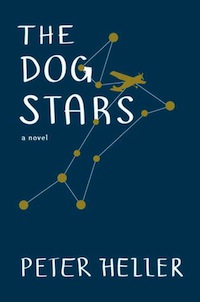Bemoaning an abundance of dystopian or post-apocalyptic fiction right now isn’t exactly fair. During the Cold War, there was a flood of sci-fi dealing with nuclear war and fallout. Now, the reason zombies are ambling through our fiction, or the Earth’s orbit is slowing, or deadly viruses are spreading, is because authors have climate change, flu epidemics, technology failures and other 21st century problems on their minds. In this way, Peter Heller’s The Dog Stars stands in line with other post-society Earth-as-a-disaster-area books released this year. But there’s one major difference: Heller approaches the task like a poet.
The novel’s narration comes from a man named Hig, in his forties and a survivor a strange, flu-like virus that has swept the planet. Hig is a pilot and regularly makes runs or patrols in his Cessna, which he calls “The Beast.” If Hig is a post-apocalyptic, lyrical Han Solo, then his Chewbacca is his faithful dog, Jasper, and the descriptions of Hig altering the cockpit in various ways to accommodate Jasper are at once touching and practical. There’s also the small tragedy of Jasper likely being deaf from the noise of the plane. Heller does a good job of heaping a lot of the repressed mourning and angst of Hig into small compact phrases concerning how Hig feels about Jasper:
He’s getting old. I don’t count the years. I don’t multiply by seven.
They bred dogs for everything else, even diving for fish, why didn’t they breed them to live longer, to live as long as a man?
These kinds of short, punctuated sentences pervade the whole of The Dog Stars. In some ways it helps to convey the facts about this world faster. In other ways, the reader feels like they’re getting this terrible version of Earth through a minimalistic poetic viewpoint. But this isn’t a flowery poetic style. Heller has a background as an outdoorsman, and frequently writes non-fiction for Outside Magazine, Natural Geographic Adventure, and similar periodicals. Naturally, this helps create a sense of total authenticity to the survival strategies employed by both Hig, and the other major character, Bangley. If Nick Frost’s gun-toting survivalist character from Spaced were rewritten without irony or slapstick humor, he’d likely be Bangley. A killer and a survivor, Bangley is a creepy, violent guy that Hig isn’t sure he actually needs to be around. As I read, I kept feeling like Bangley could have turned on me at any second. Hig needs this character to protect the “perimeter” and to keep various infected human survivors away from them. In this catastrophic scenario, uninfected human beings behave like they’re avoiding zombies; except the zombies are just other sick and desperate humans.
There are shades of Jose Saramago’s Blindness here, if not in tone or structure, then in the story’s implications. But Heller is more of a Hemingway in this sense, dedicated to showing the reader the tip of the iceberg of this burnt out, pandemic-swept world rather than getting into the specifics.
Most jarringly, the novel often switches between past and present tense in an effort or relate Hig’s actions and feelings in the relative present, contrasted with events in the past, including the painful death of his wife. Unrelenting pain combined with a need for said pain is an over-arching theme in The Dog Stars, one Heller makes plain in a passage in which he describes Hig’s cache of music.
What I can play is blues. She was never that into blues. I can salve with Lightning and Cotton, BB and Clapton and Stevie Ray. I can blast Son Seals singing Dear Son until the coyotes in the creek raise up a sympathetic sky ripping interpretation of the harmonica solo. Piercing howls and yelps. Sounds like it’s killing them and they also love it. Which when you get right down to it is the blues.
For me, this early passage laid out the rest of the thematic drive of the novel: a lonely story of a man and his dog, taking to the skies in desperation and hope that some sort of version of the old world is out there. And yet, the journey itself is what takes on the most importance, rather than what they actually achieve. The Dog Stars is a novel that will make you sad, but maybe end-of-the-world and post-apocalyptic Earth stories are supposed to make us feel this way. Maybe many of these books, like The Flame Alphabet, The Age of Miracles, and now The Dog Stars are allowing us to feel what it’s like to have something “killing us” but also love it. Is that too reductive? Are awesome literary novels with science fiction elements about the end of the world just a literary version of the blues?
Perhaps this doesn’t apply to the other novels, but The Dog Stars certainly is. It’s science fiction, survivalist fiction, and most accurately, post-society blues.
Ryan Britt is the staff writer for Tor.com.










